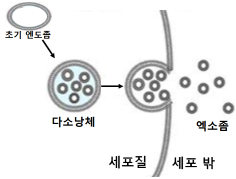06 what is an exosome?
페이지 정보

본문
Panacell Biotech, a Ministry of Food and Drug Safety cell processing certification body and a stem cell research institute, established a cosmetics company as a subsidiary. The cosmetics that will be produced there are functional cosmetics that contain exosomes and are known to have an excellent absorption rate in the human body. In addition, Panacell Biotech has established a manufacturing method for exosomes derived from NK cell culture fluid, exosomes derived from adipose-derived stem cell (ADSC) culture fluid, and exosomes derived from whey (liquid remaining after milk has curdled and coagulated) and exosomes manufactured using this method. We have three patents pending for cosmetic compositions containing moths.
1. What is an exosome?
The dictionary definition of exosome is an extracellular vesicle. A vesicle means a small sac, and in biology, a sac is a structure surrounded by a membrane, such as a cell membrane. The term exosome was first used about 30 years ago, and when it was first used, the definition was unclear and it was considered to be just a vesicle that exists outside the cell. However, recently, exosomes have been studied more deeply and are accurately defined. According to the recent definition, exosomes refer only to extracellular vesicles released from cells through the fusion of the cell membrane with an intracellular organelle called a multivesicular body derived from endosomes. The key point here is that the polycystic body is involved in the middle.

2. Why did exosomes come into the spotlight?
There are approximately three reasons why exosome research has come into the spotlight. First, exosomes become a means of communication between cells, allowing them to exchange polymer substances with each other. Second, exosomes can be a delivery vehicle for proteins, fats, mRNA, miRNA, and DNA. Third, exosomes can be a useful delivery vehicle for drugs such as anticancer drugs. In other words, doctors and scientists are beginning to pay attention to the fact that exosomes can be useful as a means of delivering substances.
3. How did exosomes acquire the ability to transmit substances?
The answer can be easily obtained by understanding the process by which early

endosomes are converted into multivesicular bodies.
Early endosomes go through an invagination process and become multicystic bodies, and when invagination, various components of the cytoplasm are captured together.
endosomes are converted into multivesicular bodies.
Early endosomes go through an invagination process and become multicystic bodies, and when invagination, various components of the cytoplasm are captured together. Therefore, the vesicles present in the polyvesicles can contain various cytoplasmic substances. If there are many anticancer drugs in the cytoplasm, the vesicles of the multivesicles capture the anticancer drugs, and these vesicles can deliver the anticancer drugs to other cells released as exosomes.
4. How can I obtain exosomes?
It can be obtained from the culture fluid of cultured cells. Of course, it can only be obtained from the culture medium of cells that can produce exosomes. To date, immune-related cells such as B cells, dendritic cells, mast cells, and adipose stem cells (ADSC), which are of interest to us, are known to be able to release exosomes, so exosomes can be purified from the culture medium of these cells. To purify exosomes, ultracentrifugation or filtration is used, and a method called tangential flow filtration (TFF) is introduced as shown in the picture.

The culture medium contains a large amount of plasma proteins that can cause an immune response when injected into a patient. When this culture medium is passed through the center of the filter, the proteins are removed by passing through the filter and only exosomes remain for purification.
5. What are the pros and cons of exosomes compared to stem cell therapy?
Since exosomes are not cells, there is absolutely no possibility of becoming cancerous, and since they can be sterilized before use, there is no risk of infection by bacteria. Additionally, because it is small in size, it can easily spread to every corner of the body, including the brain, and because it does not cause an immune response, it can be used universally for all people. It is not toxic because it is not an artificial synthetic substance. On the other hand, unlike cells, the duration is short, so repeated and continuous injections are required, and the possibility of settlement after differentiation into specific cells, as expected from ADSC, cannot be taken into account. Despite these shortcomings, if exosomes can be mass-produced and preserved and used like regular injections, it seems possible to maximize the advantages of exosomes and open a new era in therapeutics.
6. What therapeutic effects do exosomes derived from ADSCs exhibit?
In an experiment conducted on mice, results were announced showing that a good therapeutic effect was observed when exosomes extracted from ADSC culture were treated with mice suffering from multiple sclerosis. In addition, a study was published showing that when ADSC-derived exosomes were treated with Alzheimer's-induced mice, the amount of Alzheimer's-causing substances was reduced and the death of nerve cells was reduced, resulting in the effect of treating Alzheimer's disease. In addition to these results, ADSC-derived exosomes showed effects in preventing hypoxic cell damage in the lung and treating atopy.
Therefore, if ADSC-derived exosomes can be mass-produced and distributed at a low price, it may provide hope to various patients suffering from chronic and intractable diseases.
1. What is an exosome?
The dictionary definition of exosome is an extracellular vesicle. A vesicle means a small sac, and in biology, a sac is a structure surrounded by a membrane, such as a cell membrane. The term exosome was first used about 30 years ago, and when it was first used, the definition was unclear and it was considered to be just a vesicle that exists outside the cell. However, recently, exosomes have been studied more deeply and are accurately defined. According to the recent definition, exosomes refer only to extracellular vesicles released from cells through the fusion of the cell membrane with an intracellular organelle called a multivesicular body derived from endosomes. The key point here is that the polycystic body is involved in the middle.

2. Why did exosomes come into the spotlight?
There are approximately three reasons why exosome research has come into the spotlight. First, exosomes become a means of communication between cells, allowing them to exchange polymer substances with each other. Second, exosomes can be a delivery vehicle for proteins, fats, mRNA, miRNA, and DNA. Third, exosomes can be a useful delivery vehicle for drugs such as anticancer drugs. In other words, doctors and scientists are beginning to pay attention to the fact that exosomes can be useful as a means of delivering substances.
3. How did exosomes acquire the ability to transmit substances?
The answer can be easily obtained by understanding the process by which early

endosomes are converted into multivesicular bodies.
Early endosomes go through an invagination process and become multicystic bodies, and when invagination, various components of the cytoplasm are captured together.
endosomes are converted into multivesicular bodies.
Early endosomes go through an invagination process and become multicystic bodies, and when invagination, various components of the cytoplasm are captured together. Therefore, the vesicles present in the polyvesicles can contain various cytoplasmic substances. If there are many anticancer drugs in the cytoplasm, the vesicles of the multivesicles capture the anticancer drugs, and these vesicles can deliver the anticancer drugs to other cells released as exosomes.
4. How can I obtain exosomes?
It can be obtained from the culture fluid of cultured cells. Of course, it can only be obtained from the culture medium of cells that can produce exosomes. To date, immune-related cells such as B cells, dendritic cells, mast cells, and adipose stem cells (ADSC), which are of interest to us, are known to be able to release exosomes, so exosomes can be purified from the culture medium of these cells. To purify exosomes, ultracentrifugation or filtration is used, and a method called tangential flow filtration (TFF) is introduced as shown in the picture.

The culture medium contains a large amount of plasma proteins that can cause an immune response when injected into a patient. When this culture medium is passed through the center of the filter, the proteins are removed by passing through the filter and only exosomes remain for purification.
5. What are the pros and cons of exosomes compared to stem cell therapy?
Since exosomes are not cells, there is absolutely no possibility of becoming cancerous, and since they can be sterilized before use, there is no risk of infection by bacteria. Additionally, because it is small in size, it can easily spread to every corner of the body, including the brain, and because it does not cause an immune response, it can be used universally for all people. It is not toxic because it is not an artificial synthetic substance. On the other hand, unlike cells, the duration is short, so repeated and continuous injections are required, and the possibility of settlement after differentiation into specific cells, as expected from ADSC, cannot be taken into account. Despite these shortcomings, if exosomes can be mass-produced and preserved and used like regular injections, it seems possible to maximize the advantages of exosomes and open a new era in therapeutics.
6. What therapeutic effects do exosomes derived from ADSCs exhibit?
In an experiment conducted on mice, results were announced showing that a good therapeutic effect was observed when exosomes extracted from ADSC culture were treated with mice suffering from multiple sclerosis. In addition, a study was published showing that when ADSC-derived exosomes were treated with Alzheimer's-induced mice, the amount of Alzheimer's-causing substances was reduced and the death of nerve cells was reduced, resulting in the effect of treating Alzheimer's disease. In addition to these results, ADSC-derived exosomes showed effects in preventing hypoxic cell damage in the lung and treating atopy.
Therefore, if ADSC-derived exosomes can be mass-produced and distributed at a low price, it may provide hope to various patients suffering from chronic and intractable diseases.
- PrevNK (Natural Killer) Cells and Immunity 24.04.16
- NextTreatment of lung disease by ADSC 24.04.16
댓글목록
등록된 댓글이 없습니다.






 +82-2-532-2856
+82-2-532-2856 info@panacellbio.com
info@panacellbio.com 521, Teheran-ro, Gangnam-gu, Seoul, Republic of Korea
521, Teheran-ro, Gangnam-gu, Seoul, Republic of Korea